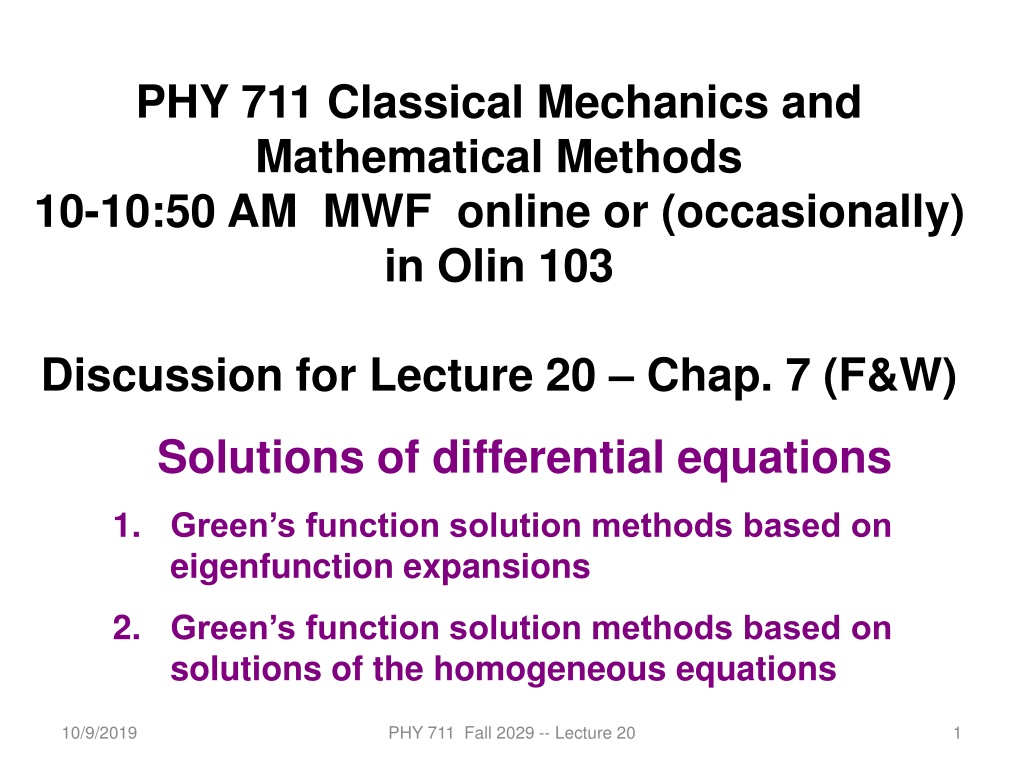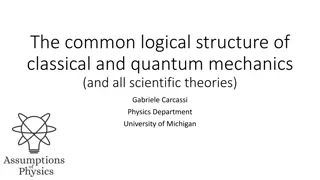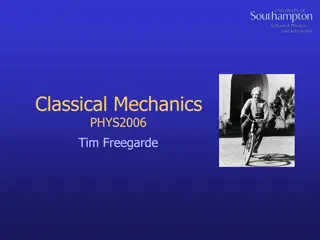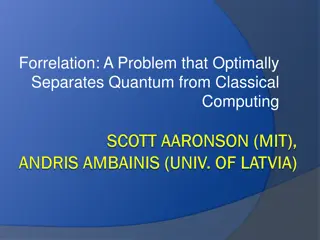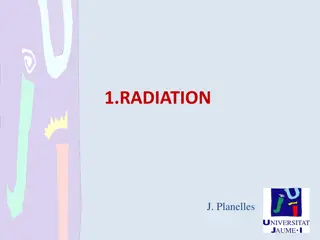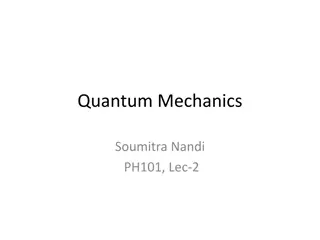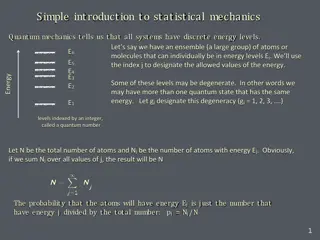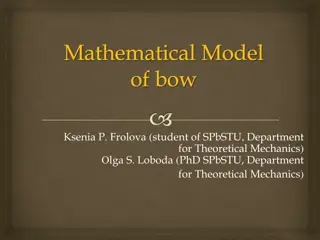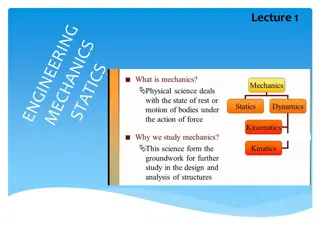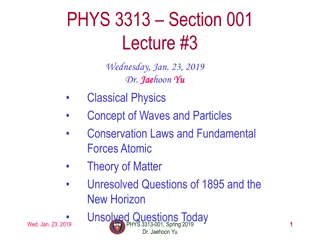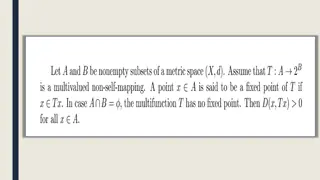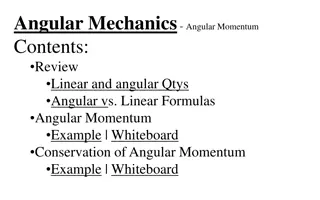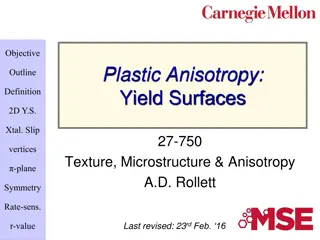Classical Mechanics and Mathematical Methods Lecture 20 Overview
The lecture covered solutions of differential equations using Green's function methods based on eigenfunction expansions. Topics included finding formal solutions, motivations behind Green's functions, and understanding Sturm-Liouville equations for homogenous and inhomogenous problems. Students had questions on Raleigh-Ritz estimates, homogeneous equations, and deriving formal solutions.
- Classical Mechanics
- Mathematical Methods
- Greens Functions
- Sturm-Liouville Equations
- Differential Equations
Download Presentation

Please find below an Image/Link to download the presentation.
The content on the website is provided AS IS for your information and personal use only. It may not be sold, licensed, or shared on other websites without obtaining consent from the author. Download presentation by click this link. If you encounter any issues during the download, it is possible that the publisher has removed the file from their server.
E N D
Presentation Transcript
PHY 711 Classical Mechanics and Mathematical Methods 10-10:50 AM MWF online or (occasionally) in Olin 103 Discussion for Lecture 20 Chap. 7 (F&W) Solutions of differential equations 1. Green s function solution methods based on eigenfunction expansions 2. Green s function solution methods based on solutions of the homogeneous equations 10/9/2019 PHY 711 Fall 2029 -- Lecture 20 1
Schedule for weekly one-on-one meetings Nick 11 AM Monday (ED/ST) Tim 9 AM Tuesday Bamidele 7 PM Tuesday Zhi 9 PM Tuesday Jeanette 11 AM Wednesday Derek 12 PM Friday? 10/9/2019 PHY 711 Fall 2029 -- Lecture 20 2
10/9/2019 PHY 711 Fall 2029 -- Lecture 20 3
Plan for next week. Take home exam will be available on Monday 10/12/2020 and due Monday 10/19/2020. It is an open book/open note exam. According to the honor code, it must be your own work. You may consult with me, but NO ONE ELSE. The problems are likely to be similar to those you have had for homework. The synchronous lectures will continue through this period, but no additional homework will be assigned. 10/9/2019 PHY 711 Fall 2029 -- Lecture 20 4
Your questions From Tim 1) I used three different test functions for Assignment 14 and only one worked out. Is it not guaranteed that the Raleigh-Ritz estimate will always be greater than the smallest eigenvalue? 2) On slide 17, what is the homogeneous equation psi_0(x)? From Nick 1. For tomorrow there are a few steps where I'm having trouble connecting the dots. How do we arrive at the formal solution on slide 11? 2. I'm also not following how we arrive at the solution for G on slide 13. 3. Lastly, what's the motivation behind a Green's function, is it just putting all the weight on the forcing term? From Zhi 1. In slide 4 what's the difference between the solution to homogeneous function and eigenfunctions? 2. And in slide 11 how the formal solution comes out? 10/9/2019 PHY 711 Fall 2029 -- Lecture 20 5
Review Sturm-Liouville equations defined over a range of x. d dx d dx + = Homogenous problem: ( ) x ( ) v x ( ) x ( ) x 0 0 d dx d dx + = Inhomogenous problem: ( ) x ( ) v x ( ) x ( ) x ( ) F x Eigenfunctions: d dx d dx + = ( ) x ( ) v x ( ) ( ) x f x ( ) f x n n n Note that, because Sturm-Liouville operator is Hermitian, the eigenvalues are real and the eigenfunctions are orthogonal. In the last lecture, we argued that the eigenfunctions form a complete set over the range of x defined for the particular system. 10/9/2019 PHY 711 Fall 2029 -- Lecture 20 6
Your question -- In slide 4 what's the difference between the solution to homogeneous function and eigenfunctions? d dx d dx d dx d dx + = Homogenous problem: ( ) x ( ) v x ( ) x ( ) x 0 0 + = Eigenfunctions: ( ) x ( ) v x ( ) ( ) x f x ( ) f x n n n Note that for the homogeneous equation l is fixed (known) and can be 0. For the eigenfunction equations the eigenvalues n and eigenfunctions fn need to be determined. 10/9/2019 PHY 711 Fall 2029 -- Lecture 20 7
Eigenvalues and eigenfunctions of Sturm-Liouville equations In the domain : a x b d d x v x f x dx dx Alternative boundary conditions; 1. ( ) ) ( ) or 2. x dx + = ( ) ( ) ( ) ( ) x f x ( ) n n n = = ( ) x 0 f a f b m m ( ( ) dx df dx df x df = = ( ) x 0 m m a b ( ) a ( ) x d d f b = = or 3. ( ) ( ) nd b a m m f a f m m Properties: Eigenvalues are real n b ( ) x f x f = Eigenfunctions are orthogonal: ( ) ( ) x dx , N n m nm n a b 2 where ( )( x ( )) f x . N dx n n a 10/9/2019 PHY 711 Fall 2029 -- Lecture 20 8
Variation approximation to lowest eigenvalue In general, there are several techniques to determine the eigenvalues nand eigenfunctions fn(x). When it is not possible to find the ``exact'' functions, there are several powerful approximation techniques. For example, the lowest eigenvalue can be approximated by minimizing the function , h h d dx d dx h S h + ( ) S x ( ) x ( ) v x 0 ( ) h x where is a variable function which satisfies the correct boundary values. The ``proof'' of this inequality is based on the notion that can in principle be expanded in terms of the (unknown) exact eigenfunctions fn(x): where the coefficients Cn can be ( ) ( ), n n n ( ) h x = h x C f x assumed to be real. 10/9/2019 PHY 711 Fall 2029 -- Lecture 20 9
Estimation of the lowest eigenvalue continued: From the eigenfunction equation, we know that ( ) ( ) ( ) n It follows that: ( ) ( ) ( ) a It also follows that : = = ( ) ( ) x f x ( ). S x h x S x C f x C n n n n n n b = = N 2 | C | . h S h h x S x h x dx n n n n b = = ( ) ( ) ( ) h x 2 | C | , h h x h x dx N n n a n 2 | C | N h S h n n n = Therefore . n 0 2 | C | N h h n n n 10/9/2019 PHY 711 Fall 2029 -- Lecture 20 10
Rayleigh-Ritz method of estimating the lowest eigenvalue h S h , 0 h h 2 d dx = = = Example: ( ) x ( ) with (0) x ( ) 0 f f f f a n n n n n 2 = trial function ( ) x ( ) f x x a trial 2 9.869604404 a = = Exact value of 0 2 2 a 2 d dx ( ) ( ) x a x x a x 10 a 2 = Raleigh-Ritz estimate: ( ) ( x x a ) 2 x a x 10/9/2019 PHY 711 Fall 2029 -- Lecture 20 11
Your question I used three different test functions for Assignment 14 and only one worked out. Is it not guaranteed that the Raleigh-Ritz estimate will always be greater than the smallest eigenvalue? Comment The proof is compelling. I am now thinking that the problem is not as well posed as it should be. Nick pointed out that the lowest eigenvalue is 0 for a constant function. In order to get the next eigenvalue of pi^2, you need to modify the method to choose functions orthogonal to the lowest eigenfunction. 10/9/2019 PHY 711 Fall 2029 -- Lecture 20 12
Rayleigh-Ritz method of estimating the lowest eigenvalue h S h 2 2 2 ( ) Example: n x G x d x Another example this time with a variable parameter , 0 h d f h ( ) x + = = ( ) = ( ) with ( x ) 0 n x f f f f n n n n 2 = gx trial function ( ) f e trial f f S f G trial trial = + Raleigh-Ritz estimate: ( ) g g trial 4 g f trial trial trial( ) G g / g G Note that for differential equation of the Schoedinger equation of the harmonic oscillator: 2 G= = 1 2 = = ( ) g G g G m mE 0 trial 0 = E trial 0 0 2 2 10/9/2019 PHY 711 Fall 2029 -- Lecture 20 13
Recap -- Rayleigh-Ritz method of estimating the lowest eigenvalue Example from Schroedinger eq ( ) ( ) 2 2 ( x e f = uation f r one-dimensional o harmonic oscillator: 2 2 1 d f x + = = = 2 2 ( ) with ( x ) ( ) 0 m x f x E f f f n x n n n n n 2 m d 2 gx Trial functi o n ) trial f f S f 2 2 2 2 / m trial trial = + Raleigh- Ritz estima e: t ( ) g g E trial 2 4 m g f trial 1 2 trial m Exact answer = = ( ) g E g 0 trial 0 Do you think that there is a reason for getting the correct answer from this method? a. Chance only b. Skill 10/9/2019 PHY 711 Fall 2029 -- Lecture 20 14
Solution to inhomogeneous problem by using Greens functions Inhomogenous problem: d d x v x dx dx : function s Green' d x dx Formal solution: + = ( ) ( ) ( ) x ( ) x ( ) F x d ( ) ' x + = ( ) ( ) ( ) ( , ) ' x v x x G x x dx b + ( ) x = ( ) x ( , ') ( ') G x x F x dx ' 0 a Solution to homogeneous problem 10/9/2019 PHY 711 Fall 2029 -- Lecture 20 15
Formal solution: b + ( ) x = ( ) x ( , ') ( ') G x x F x dx ' 0 a Solution to homogeneous problem Your question -- On slide 17, what is the homogeneous equation psi_0(x)? d dx Homogenous problem: d x dx + = ( ) ( ) v x ( ) x ( ) x 0 0 In this lecture, we will discuss several methods of finding this Green s function. This topic will also appear in PHY 712 10/9/2019 PHY 711 Fall 2029 -- Lecture 20 16
Your question -- How do we arrive at the formal solution on slide 11? Formal solution: b + ( ) x = ( ) x ( , ') ( ') G x x F x dx ' 0 a Note that this form satisfies the inhomogenous equation d d S x x dx dx + Define ( ) ( ) ( ) v x ( ) x b ( ) x = + ( ) S x ( ) S x ( ) x ( ) S x ( , ') ( ') G x x F x dx ' 0 a b ( ) x = = ( ) S x 0 + ( ') ( ') x F x dx ' ( ) x F x a 10/9/2019 PHY 711 Fall 2029 -- Lecture 20 17
Suppose that we can find a Green's function defined as follows: d d x v x x G x x dx dx ( ) + = ( ) ( ) ( ) ( , ') ' x x Completeness of eigenfunctions: ( ) ( ') n n f x f x N In terms of eigenfunctions: d d x v x dx dx f x f x G x x = Recall: ( ) x ( ) = ' x x n n ( ) ( ') f x f x N ( ) x + = ( ) ( ) ( ) x ( , ') G x x n n n n ( ) ( ')/ N By construction ( , ') n n n n n 10/9/2019 PHY 711 Fall 2029 -- Lecture 20 18
Example Sturm-Liouville problem: = 1; ( ) = = = = Example: ( ) 1; ( ) 0; 0 and x x v x a b L x = = 1; ( ) sin F x F 0 L Inhomogenous equation: 2 d dx x = 1 ( ) x sin F 0 2 L 10/9/2019 PHY 711 Fall 2029 -- Lecture 20 19
Eigenvalue dx equation : 2 d = ( ) ( ) f x f x n n n 2 Eigenfunct ions Eigenvalue : s 2 2 L n x n = = ( ) sin f x n n L L Completene ss x of f n eigenfunct ions : ( ) N ( ) ' x f ( ) x ( ) = ' n x x n n 2 L ' n x n x ( ) ' x = In this example : sin sin x L L n 10/9/2019 PHY 711 Fall 2029 -- Lecture 20 20
Green' function s d x : d ( ) ' x + = ( ) ( ) ( ) ( , ) ' x v x x G x x dx dx Green' function s for the example : ' n x n x sin sin ( ) ( / ) ' 2 f x f x N L L n n = = n n n G(x,x') 2 L n n 1 L 10/9/2019 PHY 711 Fall 2029 -- Lecture 20 21
Using Green's function to solve inhomogenous equation: = 2 d dx x 1 ( ) x sin with boundary values (0)= ( )=0 F L 0 2 L L ' x = + ( ) x ( ) x ( , ') G x x F sin ' dx 0 0 L 0 n x L 2 sin L 2 L ' ' n x L x = + ( ) x sin sin ' F dx 0 0 L n n 0 1 L F x = + ( ) x sin 0 2 0 L 1 L 10/9/2019 PHY 711 Fall 2029 -- Lecture 20 22
Alternate Green's function method not based on eigenvalues but on solutions to the homogeneous problem: 1 ( , ') for 0 a b G x x g x g x W d g x dx ( ) ( ) ( ) sin L = = + ( ) ( ) = x L 2 ( ) x ( ) x = = = 1 ( ) 0 sin( ); x s in( ); g g L x i a b 2 ( ) x dx dg x dg ( ) x ( ) ( ) x ( ) x ( ) = = + a dx b sin cos sin cos W g g x L x L x b a x sin( sin( ) ) ' L x x ( ) x ( ) x sin( ') sin ' x F dx 0 0 L L 0 L sin( ) sin( ) ' x L x + sin( ') sin ' L x F dx 0 L x F x Hurray! Same as before. = + ( ) x ( ) x sin 0 2 0 L 1 L 10/9/2019 PHY 711 Fall 2029 -- Lecture 20 23
More details on the general method of constructing Greens functions using homogeneous solution : function s Green' d x dx d ( ) ' x + = ( ) ( ) ( ) ( , ) ' x v x x G x x dx Two homogeneous solutions d d x dx dx + = = ( ) ( ) v x ( ) x ( ) 0 for , g x i a b i Let 1 = ( , ') ( ) ( ) G x x g x g x a b W 10/9/2019 PHY 711 Fall 2029 -- Lecture 20 24
For 0: + + ' ' x x d dx d dx ( ) + = ( ) x ( ) v x ( ) x ( , ' ) ' dx G x x dx x x + ' ' x x ' x 1 d dx d dx W = ( ) x ( ) ( ) 1 dx g x g x a b ' x + ' x ( ) x W ( ') x W d dx d dx d d = ( ) ( ) ( ') x ( ') ( ') x ( ' x ) g x g x g g x g g a b a b b a x ' x d d d dxg = ( ') x ( ') x ( ') ( ') x ( ') x W g g x g a b b a x dW dx = Note -- (Wronskian) is constant, since 0. W ' Useful Green's function construction in one dimension: 1 ( , ' ( ) ( ) ) a b G x x g x x g W = 10/9/2019 PHY 711 Fall 2029 -- Lecture 20 25
d dx d dx + = ( ) x ( ) v x ( ) x ( ) x ( ) F x Green's function solution: b ( ) x = + ( ) x ( , ') ( ') G x x F x dx ' 0 a x b ( ) W ( ) W g x g x + + = ( ) x ( ') ( ') ' ( ') ( ) ' ' g x F x dx g x F x dx b a 0 a b a x Note that the integral has to be performed in two parts. While the eigenfunction expansion method can be generalized to 2 and 3 dimensions, this method only works for one dimension. 10/9/2019 PHY 711 Fall 2029 -- Lecture 20 26
Another example -- d dx 2 = ( )/ x ( ) x electrostatic potential for charge density ( ) x 0 2 Homogeneous equation: d dx = 2 = ( ) x 0 g , a b 2 = Let Wronskian: ( ) ( ) 1 g x x g x a b ( ) dx ( ) x dg x dg x d = = ( ) x ( ) 1 W g g x b a a b Green ( , ') G x x 's function: = x x 1 x = + + ' ( ( ) x ( ) x ' ' ( ) dx x ) x dx x 0 0 0 x 10/9/2019 PHY 711 Fall 2029 -- Lecture 20 27
Example -- continued d dx 2 = ( ) / x ( ) x electrostatic potential for cha rge density ( ) x 0 2 x 1 x = + + ( ) x ( ) ' ' ( ) x ' ( ) x x dx x d x 0 0 0 x 0 x a x = Suppose ( ) x / x a a a 0 0 x a 0 x a 3 2 3 a 3 xa x = + + ( ) x ( ) x 0 a a x a 0 2 6 0 2 2 a x a 0 3 0 10/9/2019 PHY 711 Fall 2029 -- Lecture 20 28
0 x a 3 2 3 a xa x = + ( ) x 0 a a x a 3 2 6 0 2 2 a x a 0 3 0 10/9/2019 PHY 711 Fall 2029 -- Lecture 20 29
